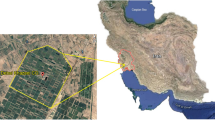Abstract
The problem of selecting sugarcane varieties has been widely discussed due to its computational complexity and its great impact for the sugar and ethanol industry. This paper proposes a new integrated mathematical programming model to deal with the selection of sugarcane varieties to be planted and the determination of the optimal period for planting and harvesting in order to increase production in the sugarcane industry. The proposed model optimizes the production of sugarcane and improves the quality of biomass whilst satisfying the main constraints imposed by sugarcane companies. The problem is modelled as an integer linear program and solved using an exact method to generate optimal solutions for small and medium problems. For large problems, metaheuristic approaches based on Genetic Algorithm and Variable Neighbourhood Search are proposed. According to the results, the proposed methodology provides sugarcane company managers with decision support in selecting the most suitable varieties and in determining the best period to plant and harvest their sugarcane.



Similar content being viewed by others
References
Bolboaca, S., Jantschi, L., Balan, V., Diudea, M., & Sestras, R. (2010). State of art in genetic algorithms for agricultural systems. Notulae Botanicae Horti Agrobotanici Cluj-Napoca, 38(3), 51–63.
Brimberg, J., & Mladenovic, N. (1996). A variable neighbourhood algorithm for solving the continuous location–allocation problem. Studies of Locational Analysis, 10, 1–12.
Calija, A. V., Higgins, J. L. P. A., & Bielig, C. D. (2001). An operations research approach to the problem of the sugarcane selection. Annals of Operations Research, 108, 123–142.
Colin, E. C. (2009). Mathematical programming accelerates implementation of agro-industrial sugarcane complex. European Journal of Operational Research, 199(1), 232–235.
Engelke, J. (2002). Sugarcane: Measuring commercial quality. Tech. rep., FARMNOTE Department of Agriculture, Kununurra, Australia, n. 23.
Florentino, H. O., Irawan, C., Aliano, A. F., Jones, D. F., Cantane, D. R., & Nervis, J. J. (2017). A multiple objective methodology for sugarcane harvest management with varying maturation periods. Annals of Operations Research,. https://doi.org/10.1007/s10479-017-2568-2.
Florentino, H. O., & Pato, M. V. (2014). A bi-objective genetic approach for the selection of sugarcane varieties to comply with environmental and economic requirements. Journal of the Operational Research Society, 65(6), 842–854.
Florentino, H. O., Moreno, E. V., & Sartori, M. M. A. P. (2008). Multiobjective optimization of economic balances of sugarcane harvest biomass. Scientia Agricola, 65, 561–564.
Florentino, H. O., Lima, A. D. D., Carvalho, L. R. D., Balbo, A. R., & Homem, T. P. D. (2011). Multiobjective 0–1 integer programming for the use of sugarcane residual biomass in energy cogeneration. International Transactions in Operational Research, 18(5), 605–615.
Goldberg, D. E. (1989). Genetic Algorithms in Search. Optimization and Machine Learning: Addison-Wesley, Reading, Massachusetts. https://doi.org/10.1023/A:1022602019183.
Hansen, P., & Mladenovic, N. (1997). Variable neighbourhood search for the p-median. Location Science, 5, 207–225.
Higgins, A., & Laredo, L. A. (2006). Improving harvesting and transport planning within a sugar value chain. Journal of the Operational Research Society, 57, 367–376.
Higgins, A., Muchow, R., & Rudd, A. (1998). Optimising harvest date in sugar production: A case study for the mossman mill region in australia: I. Development of operations research model and solution. Field Crops Research, 57(2), 153–162.
Higgins, A., Antony, G., Sandell, G., Davies, I., Prestwidge, D., & Andrew, B. (2004). A framework for integrating a complex harvesting and transport system for sugar production. Agricultural Systems, 82(2), 99–115.
Holland, J. H. (1992). Adaptation in natural and artificial systems. Cambridge: MIT Press. https://doi.org/10.1137/1018105.
Jena, S. D., & Poggi, M. (2013). Harvest planning in the brazilian sugar cane industry via mixed integer programming. European Journal of Operational Research, 230(2), 374–384.
Leboreiro, J., & Hilaly, A. K. (2011). Biomass transportation model and optimum plant size for the production of ethanol. Bioresource Technology, 102(3), 2712–2723.
Paiva, R. R. P. O., & Morabito, R. (2009). An optimization model for the aggregate production planning of a Brazilian sugar and ethanol milling company. Annals of Operations Research, 169, 117.
Piewthongngam, K., Pathumnakul, S., & Setthanan, K. (2009). Application of crop growth simulation and mathematical modeling to supply chain management in the thai sugar industry. Agricultural Systems, 102(1), 58–66.
Ramos, R. P., Isler, P. R., Florentino, H. O., Jones, D., & Nervis, J. J. (2016). An optimization model for the combined planning and harvesting of sugarcane with maturity considerations. African Journal of Agricultural Research, 11, 3950–3958.
Sartori, M. M. P., de Oliveira, F. H., Basta, C., & Leão, A. L. (2001). Determination of the optimal quantity of crop residues for energy in sugarcane crop management using linear programming in variety selection and planting strategy. Energy, 26(11), 1031–1040.
Scarpari, M., & Beauclair, E. (2010). Optimized agricultural planning of sugarcane using linear programming. Investigacion operacional, 31, 126–132.
Shukla, M., & Jharkharia, S. (2014). Harvest scheduling to reduce waste in agri-fresh produce supply chains: An artificial immune system-based solution approach. International Journal of Planning and Scheduling, 2(1), 14–39.
Acknowledgements
To Brazilian foundations: Conselho Nacional de Desenvolvimento Científico e Tecnológico - CNPq (Grant Number 312551/2019-3), Pró-Reitoria de Pesquisa da UNESP - PROPE, Fundação para o Desenvolvimento da UNESP - FUNDUNESP and Fundação de Amparo ã Pesquisa do Estado de São Paulo - FAPESP (Grant Numbers 2014/01604-0 and 2014/04353-8) for their financial support.
Author information
Authors and Affiliations
Corresponding author
Additional information
Publisher's Note
Springer Nature remains neutral with regard to jurisdictional claims in published maps and institutional affiliations.
Rights and permissions
About this article
Cite this article
Florentino, H.d.O., Jones, D.F., Irawan, C.A. et al. An optimization model for combined selecting, planting and harvesting sugarcane varieties. Ann Oper Res 314, 451–469 (2022). https://doi.org/10.1007/s10479-020-03610-y
Published:
Issue Date:
DOI: https://doi.org/10.1007/s10479-020-03610-y




